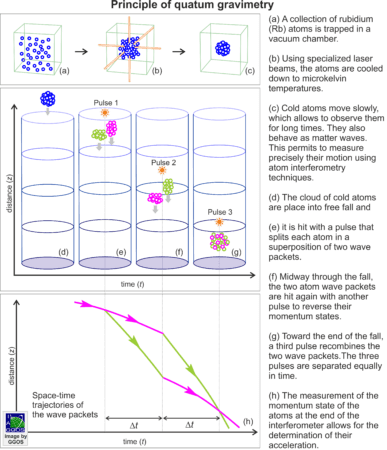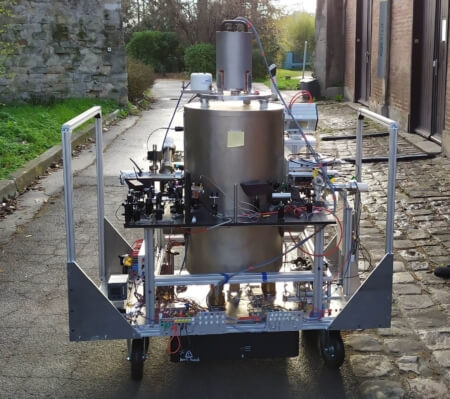Quantum Gravimetry
Gravimetry is the measurement of gravity, and gravity (also referred to as gravitation) is the universal force of attraction acting between all masses. On the Earth’s surface, gravity is a superposition of the gravitational attraction of masses and the centrifugal acceleration due to the rotation of the Earth. Time and space dependent changes of gravity yield valuable information on the distribution and movement of Earth’s masses. The more sensitive the sensor is in measuring gravity, the smaller changes in the distribution of Earth’s masses can be identified. This is of high importance for modelling and monitoring geodynamic and geophysical processes such as glacier melting, groundwater changes, flooding, volcanism, etc. (gravity field – temporal variations). Gravity measurements can be based on the analysis of satellite orbits, using sensors on dedicated gravity satellite missions, or using terrestrial techniques.
Quantum gravimetry measures the acceleration of gravity, g, by using freely falling atoms as test masses. Gravimeters employing quantum mechanical techniques comprise the newest class of instruments, and they promise to combine the best characteristics of classical absolute and relative gravimeters: portable, absolute devices (with accuracies of a few 10s of nms-2) that can run continuously (like the best relative instruments). In a quantum gravimeter, a cloud of atoms is first trapped in a vacuum chamber and cooled down with lasers to microkelvin temperatures, before being released or launched upwards in free fall. The measurement of their acceleration is then performed via atom interferometry, a technology that exploits the wave character of matter and the possibility to manipulate “atomic waves” using lasers. The atoms are thus exposed during their fall to a sequence of three laser pulses, which puts them in a quantum superposition of two different momentum states that initially separate and finally recombine, creating an atom interferometer. The relative population of each momentum state at the end of the interferometer is directly dependents on the local acceleration of gravity, g. Like classic free fall instruments, quantum gravimeters can tie their length and time measurements back to metrological standards, making them truly capable of absolute measurements.
Quantum gravimeter devices
Quantum gravimeters have been in development for about 30 years, and the technology is mature enough that commercial devices are now available. Unlike mechanical, classical absolute gravimeters, quantum instruments have very little recoil (the test masses are tiny) and they can run more or less continuously at a high rate (having no moving parts to wear out). Quantum instruments thus combine into one package the two separate and desirable aspects of previous classical instruments: absolute measurement and continuous operation. In particular, these instruments have shown excellent short-term stability and similar accuracy (in the same low 10-8 ms-2 range as assessed in international comparisons) as classical absolute gravimeters.
Drop chamber of the SYRTE gravimeter at Paris Observatory premises (courtesy S. Merlet).
Quantum gravimeters are now being deployed in the field. Static measurements are being performed in reference geodetic stations, as well as on sites of high geophysical interest, such as near volcanos. Shipborne and airborne measurement campaigns have also been realized with compact sensors placed on gyrostabilized platforms. Applications to Earth gravity field mapping in space are also envisioned, see for instance https://quantumbusinessnetwork.de/horizon-europe%e3%80%89quantum-technologies-for-space-gravimetry/.




